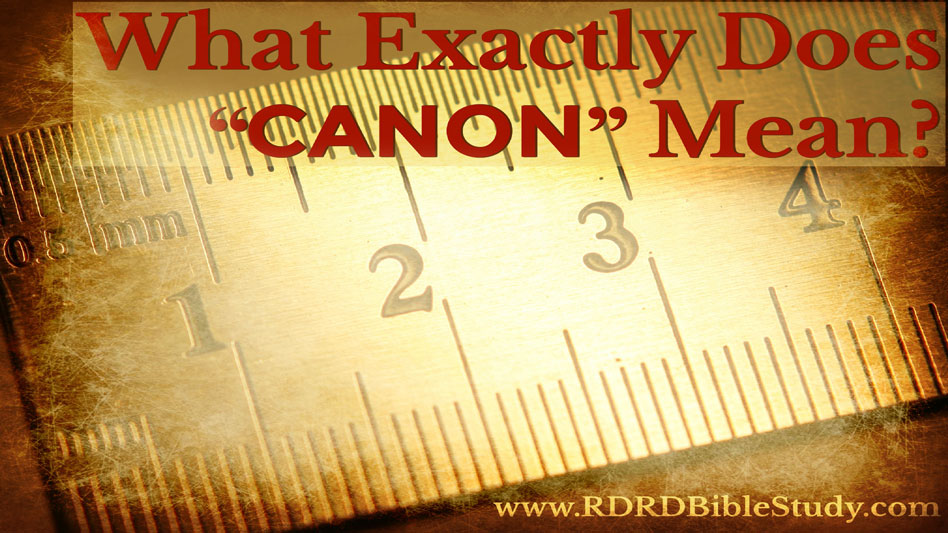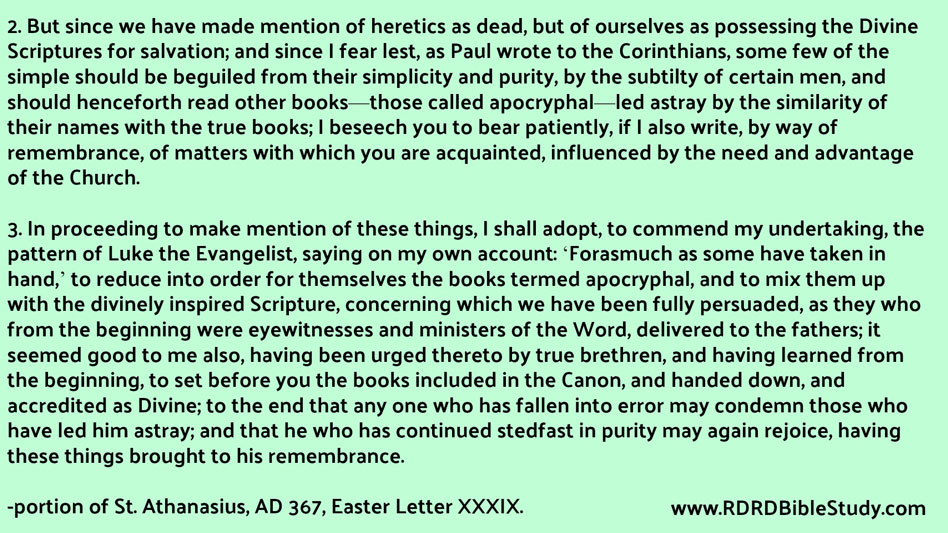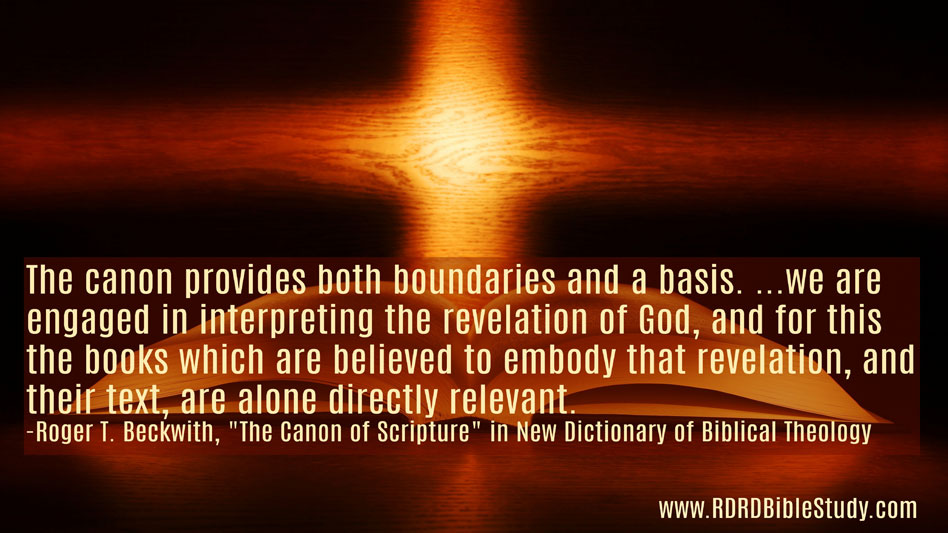What Exactly Does “Canon” Mean?
Canon comes from the Greek word denoting a straight rod or rule for measuring objects, or a criterion for judging something. According to historian Mark Noll:
Its application to the books of the Bible can thus be traced to the series of gradations found on measuring rods (hence multiple individual items gathered for one purpose) and, even more important, to the function of such measures as rules or norms (hence the sense of “canon” as standard).¹
New Testament Use Of The Word “Canon”
In the Greek NT, the word ‘canon’ describes “a means to determine the quality of something; rule or standard.” The verses below, quoted from the KJV, show how NT authors used the word before the early church used it to refer to authoritative Scripture:
- 2 Corinthians 10:13 – But we will not boast of things without our measure, but according to the measure of the rule which God hath distributed to us, a measure to reach even unto you.
- 2 Corinthians 10:15 – Not boasting of things without our measure, that is, of other men’s labours; but having hope, when your faith is increased, that we shall be enlarged by you according to our rule abundantly
- 2 Corinthians 10:16 – To preach the gospel in the regions beyond you, and not to boast in another man’s line of things made ready to our hand.
- Galatians 6:16 – And as many as walk according to this rule, peace be on them, and mercy, and upon the Israel of God.
Use Of Canon By Early Christians
The first recorded use of the word “canon” for the authoritative list of books in the Bible came in the year 367 from Athanasius, bishop of Alexandria in North Africa.
Canon, along with its cognates ‘canonical’ and ‘canonize’, began to be applied by Christian writers of the late 4th century AD to denote the correct collection and list of the sacred Scriptures.
Contemporary Use of Canon
Merriam-Webster includes both the NT and Early Christian use of the word. After ‘canon’ was used to describe the OT and NT books, it came to mean an “authorized collection of books.”
- a: an accepted principle or rule b: a criterion or standard of judgment <the canons of good taste> c : a body of principles, rules, standards, or norms <according to newspaper canon … a big story calls for a lot of copy — A. J. Liebling>
- [Middle English, from Late Latin, from Latin, standard] a : an authoritative list of books accepted as Holy Scripture b : the authentic works of a writer <the Chaucer canon> c : a sanctioned or accepted group or body of related works <the canon of great literature>
Before The Use Of Canon
Before the term ‘canon’ was used, a variety of names were used by Jews and Christians to refer to the collection of sacred books. This indicates that early on a list of books were recognized as “canonical,” that is, authoritative based on an accepted principle or standard of judgment. For example:
“Holy Scriptures” and “the Law and the Prophets” goes back to the 1st century:
- Luke 24:44 – Then he said to them, “These are my words that I spoke to you while I was still with you, that everything written about me in the Law of Moses and the Prophets and the Psalms must be fulfilled.”
- Romans 1:2 – Which he promised beforehand through his prophets in the holy Scriptures.
- Romans 3:21 – But now the righteousness of God has been manifested apart from the law, although the Law and the Prophets bear witness to it
- 2 Timothy 3:15 – You have been taught the holy Scriptures from childhood, and they have given you the wisdom to receive the salvation that comes by trusting in Christ Jesus.
- Philo, Legatio to Gaius, 3.162 – But that the food of the soul is not earthly but heavenly the Holy Scriptures will testify in many passages.
- Josephus, Antiquities of the Jews 1:5 – Now I have undertaken the present work, as thinking it will appear to all the Greeks worthy of their study; for it will contain all our antiquities, and the constitution of our government, as interpreted out of the Hebrew Scriptures.
‘Holy books’ and ‘the law and the prophets’ were used as early as 2nd century BC:
- 1 Maccabees 12:9 – Therefore, though we have no need of these things, since we have as encouragement the holy books that are in our hands.
- 2 Maccabees 15:9 – Encouraging them from the law and the prophets, and reminding them also of the struggles they had won, he made them the more eager.
Purpose Of The Language of Canonicity
What the language of canonicity added to the discussion of biblical writings was the idea of correctness. The canon provides both boundaries and a basis.
The biblical canon is a list of authoritative sacred texts. Their authority derived from the fact that they were believed to be inspired by God and so to share the nature of revelation themselves—this belief was a settled conviction among Jews of the intertestamental period and is taken for granted in the NT treatment of the OT.
That the NT shares this authority is first stated in 1 Tim 5:18 and 2 Peter 3:16:
- 1 Timothy 5:18 – For the Scripture says, “You shall not muzzle an ox when it treads out the grain,” and, “The laborer deserves his wages.”
- 2 Peter 3:16 – as he does in all his letters when he speaks in them of these matters. There are some things in them that are hard to understand, which the ignorant and unstable twist to their own destruction, as they do the other Scriptures.
The terms “Old Testament” (OT) and “New Testament” (NT) began to be used by Christian writers to refer to collections of Scriptures in the 2nd and 3rd centuries AD, so in and of themselves indicated a “canon.”
Canonical Approach
In modern biblical study and scholarship, much is written about Brevard Child’s widely supported canonical approach. The canonical approach responded to the inundation of multiple biblical criticism methods in 20th century theological academia.
Arguably the most popular of the methods, German scholar Julius Wellhausen’s Documentary Hypothesis gained almost universal acceptance during the 20th century, though it has now collapsed. This theory attempted to assign authorship of certain parts of the Old Testament to certain groups of authors, namely the Yahwists (J), Elohists (E), Deuteronomists (D), and Priestly (P). A person would be hard-pressed to find a theological book or biblical commentary written during the early and mid-twentieth century that does not reference J, E, D, and P.
Historical criticism began in the late 17th century and gained popular recognition in 19th and 20th century biblical scholarship. The historical-critical method, or higher criticism, attempts to determine the origins of ancient texts. Through the centuries historical criticism has been refined into various methodologies including but not limited to source criticism, form criticism, redaction criticism, and traditional criticism. For example, Wellhausen’s Documentary Hyposthesis is a source criticism methodology.
Canonical context, however, refers to the final form of each individual biblical book and to their position in relation to one another. In the canonical approach, Childs set out to describe the way in which texts have been shaped in order to function authoritatively in the life of the believing community.
Though some critics suggest the canonical approach exaggerates the importance of the final form (Barr and Raisanen), Childs, for his part, is trying to mediate between the critical approach of the academy and the confessional approach of the church. He presents his canonical approach as a hermeneutic common to both saints and scholars.
To read the Bible canonically is to read the Bible as a unified communicative act, that is, as the complex, multi-leveled speech act of a single divine author, an all-embracing act, that of witnessing to what God was and is doing in Christ.
Another way of saying this is that the canonical approach is a matter not of how the church reads the Bible but of what the Bible is. To read the Bible as unified Scripture is not just one interpretative interest among others, but the interpretative strategy that best corresponds to the nature of the text itself, given its divine inspiration.
Only the final form of the text displays the divine communicative act in its completeness; hence the final form is the best evidence for determining what the authors, human and divine, are ultimately doing.
Canon Conclusion
Having a canon of Scriptures is extremely important. The canon provides both boundaries and a basis. As students of the Bible, we are engaged in interpreting the revelation of God. Therefore, the books which are believed to embody that revelation, and their text, are alone relevant.
Until Next Time –
The grace of the Lord Jesus Christ and the love of God and the fellowship of the Holy Spirit be with you all. 2 Corinthians 13:14
¹Mark A. Noll, Turning Points: Decisive Moments in the History of Christianity (Grand Rapids; Baker Academic, 2000), 37.










